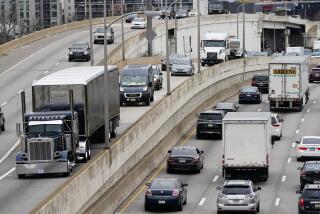Crowded Vans Give Rise to Rollovers
- Share via
WASHINGTON — Putting 10 or more people in large vans built and marketed for up to 15 occupants dramatically increases the risk of a rollover crash, a federal safety agency warned Monday.
The rollover rate of large vans carrying 10 or more occupants is nearly three times higher than when they have five or fewer people on board, the National Highway Traffic Safety Administration said in new research. The vans typically are used to transport groups such as church members, farm workers and college athletes.
Calling it “an issue of central importance,” NHTSA head Jeffrey Runge said the safety agency is considering a mandatory warning sticker on all new 15-passenger vans. “Warning labels may be effective,” Runge said. However, he suggested that driver actions are more of a problem than the design of the vans in the deadly crashes.
A leading safety researcher responded that the government’s warning, the second such alert in as many years, will do little to save lives.
“A vehicle isn’t safe to operate when you can cause it to roll simply by putting in the number of occupants the manufacturer has installed seats for,” said independent statistician Randy Whitfield, who six years ago helped identify the problem.
Public Citizen, the consumer group founded by Ralph Nader, called the NHTSA’s action “ineffectual” and said the agency should issue an advisory that no more than five people ride in the vans.
The National Transportation Safety Board said it is conducting its own study and expects to issue recommendations to the NHTSA and the industry within a year.
Auto makers say the vans are safe and that many accidents and injuries could be prevented if drivers were more careful and all occupants wore seat belts. “We don’t think there is any vehicle problem,” said Sarah Tatchio, a spokeswoman for Ford, the leading maker of large vans.
Ford uses the driver’s manual to warn consumers that large vans can be susceptible to rollover, Tatchio said. But the auto maker does not place a warning sticker in the vans, as it does in sport utility vehicles.
The NHTSA study found 388 rollovers involving 15-passenger vans from 1990 to 2000, and that 558 people died in the crashes. The study considered only those vans configured to transport passengers and not those used as work vans.
The annual average of 51 rollover fatalities in large vans is small compared to the more than 40,000 people killed every year in all vehicle crashes. But accidents involving large vans tend to be especially tragic because the victims are often young people, the elderly, or members of community organizations.
Loading the vans increases the risk of rollover because it has the effect of raising the vehicles’ already high center of gravity, NHTSA officials said. As more passengers and cargo are added, the gross weight of the vehicle increases, and more of that mass is located farther from the ground. The officials also recommended against hefting heavy articles onto roof racks. The agency’s statistical study also found that swerving was much more likely to trigger a rollover in a large van than in other passenger vehicles.
Runge recommended that organizations select only experienced people to drive large vans, that drivers be rested and avoid high speeds, and that the tires be properly inflated and in good condition. All occupants of large vans should wear seat belts, Runge stressed, since they greatly reduce the chance of being flung from the vehicle in a rollover.
“The vehicles themselves are not inherently dangerous,” Runge said. “Our comments are directed toward the training of the drivers. This is not a defect issue as much as a behavior issue with drivers and passengers.”
But Whitfield said his research showed that half of the drivers involved in large van crashes were older than 34. “These are not young, aggressive kids,” he said. “And where do you go to learn to drive a vehicle that can suddenly become unstable?”
Whitfield said the manufacturers of large vans should be required to certify a safe weight for the vehicles.
“I think it’s the responsibility of the manufacturer to tell consumers what is the maximum weight at which these vans can be loaded, and still be safe to operate,” he said.






